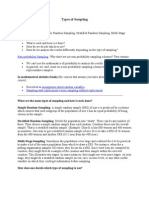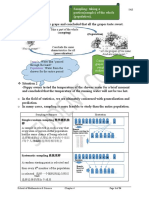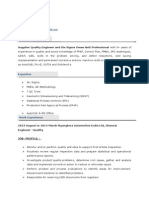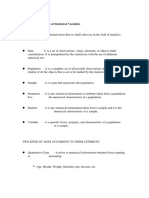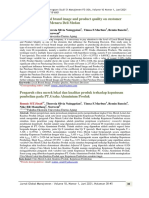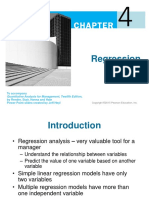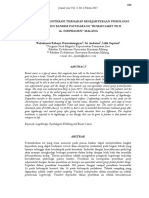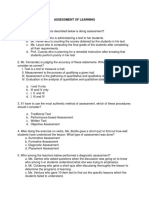BioEpi Handout #2 by LRCCo
st
1 Sem AY 2019 – 2020, FEU Manila, Dept. of Medical Technology
For class use only. Unauthorized reproduction, and distribution of this material is strictly prohibited.
Principles of Sampling
Sampling size
• Larger sample
o Waste of resources
• Small sample
o Results of no practical use
In the selection of a sample, the following questions may be asked:
1. Can we make valid conclusions about the population using a finite set of the population?
2. How large should be a sample to make its mean as close as possible to the population
mean with any desired probability?
Misconceptions for sample size estimation
• A sample size of 30 is large enough
• The ideal sample size is 10% of the population size
Sample size should depend on several factors such as the nature of the study and
sampling design used.
The Sampling Process
Identify the target population
Determine the sampling population
Choose a sampling design
Determine the sample size
Execute the sampling design
Factors that determine the sample size requirements of a given study:
1. Study design used
2. Magnitude of the parameter being estimated
3. Variability of the parameter being estimated
4. Level of precision desired
5. Data analysis plan
Factors that determine the sample size requirements of a given study:
1. How much money is available to do the work?
2. How many people can be involved in the study?
3. How fast can they work?
4. How much time is available to finish the project?
Page 1 of 6
� BioEpi Handout #2 by LRCCo
st
1 Sem AY 2019 – 2020, FEU Manila, Dept. of Medical Technology
For class use only. Unauthorized reproduction, and distribution of this material is strictly prohibited.
Size of the Sample
Sampling designs
Sampling
• Act of studying or examining only a segment of the population to represent the whole
• Whatever findings we get for this segment of the population, we generalize to the
total population
Advantages:
• Lower cost
• Shorter time
• Better quality of information
• More comprehensive data
Definition of terms:
Population: entire group of individuals or items of interest in the study
Two types:
1. Target population:
• Group for which representative information is desired and to which the inferences
will be made
2. Sampling population:
• Population from which a sample is actually taken
Sampling frame: A tool which “contains” the totality of all sampling units such that it serves
as the device to select the sampling units
Sampling units: units which are randomly drawn from the sampling frame
Elementary unit: or Element. Object or person from which a measurement is actually taken
or an observation is made
Page 2 of 6
� BioEpi Handout #2 by LRCCo
st
1 Sem AY 2019 – 2020, FEU Manila, Dept. of Medical Technology
For class use only. Unauthorized reproduction, and distribution of this material is strictly prohibited.
Criteria of a Good Sampling Design
• Representative of the population
• Adequate sample size
• Practical and feasible
• Economy and efficiency of the sampling design
Sampling Designs
• Non – probability sampling design
o Probability of each member of the population being selected as part of the
sample cannot be determined
• Probability sampling design
o Each member of the population has a known chance of being selected
Non – Probability Sampling Designs
Advantages:
• Easier to execute
• Used when it is the only possible means
Disadvantages:
• More likely to produce biased results
• No defined rules to compute for estimates
• Cannot compute the reliability of estimates
1. Judgmental or Purposive
• A ‘representative’ sample of the population is selected based on an expert’s subjective
judgment or some pre-specified criteria (e.g.: key informants, expert sampling)
2. Accidental or Haphazard
• The sample is made up of those who happen to be available at the time of data
collection
3. Quota sampling
• Samples of a fixed size (quota) are obtained from pre-determined subdivisions of the
population without the element of random selection
• Convenience sampling
• Subjects selected are those that are easily accessible
4. Snowball technique
• The subsequent subjects are usually referrals of those who were recruited earlier such
that the size of the sample gets bigger like a snowball (usually for studies among hidden
populations)
Probability Sampling Designs
1. Simple random sampling
Advantages:
• Simple design
• Simple analysis
Disadvantages:
• Not cost efficient, elementary units maybe too widespread
• Requires a sampling frame
• Most basic type of sampling
• Every element has an equal chance of being included in the sample
How to do simple random sampling?
Page 3 of 6
� BioEpi Handout #2 by LRCCo
st
1 Sem AY 2019 – 2020, FEU Manila, Dept. of Medical Technology
For class use only. Unauthorized reproduction, and distribution of this material is strictly prohibited.
Fishbowl technique
Table of Random Numbers
Construct the sampling frame (list of HH heads, map, etc.)
Calculate the sample size
Select the required number of sampling units using random numbers generated by a
calculator, excel, EpiInfo, etc.
MS EXCEL: uses the function: “RANDBETWEEN (x,y)” where x is the lowest
number and y is the highest number
2. Systematic random sampling
• Sampling units are selected at regular intervals
• The researcher computes for the sampling interval (k = N/n)
Example:
o Population size (N) = 80 households; Sample size (n) = 10
o Sampling interval k = N/n = 80/10 = 8
o Draw a number between 1 – 8 (inclusive). The number drawn will be the starting
point of the sampling. Suppose 5 is drawn:
The 5th HH is part of the sample
The next sample HH is the 13 th HH, followed by 21st, 29th, 37th, 45th, 53rd,
61st, 69th and 77th
3. Stratified random sampling
Advantages:
• Ensures that subgroups are adequately represented
• Produces more precise overall estimates
• Accurate estimates for each stratum can be obtained
Disadvantages:
• May require a very large sample if reliable estimates for each stratum are desired
The following are the steps used in stratified random sampling technique:
1. Construct the population of the participants and determine the relevant strata
2. Select the number using:
• Proportional (proportion of the strata in the population frame)
• Equal allocation (if the sizes of each stratum is almost the same)
3. Choose the participants within each category using SRS methods
The population is first divided into non – overlapping groups called (stratum) strata and
then a simple random sample is drawn per stratum
Page 4 of 6
� BioEpi Handout #2 by LRCCo
st
1 Sem AY 2019 – 2020, FEU Manila, Dept. of Medical Technology
For class use only. Unauthorized reproduction, and distribution of this material is strictly prohibited.
Examples:
Nationwide prevalence survey on drug abuse among teenagers, a major objective of the
researcher may be to derive reasonably accurate estimates of the prevalence for each
region of the country, for purposes of planning control programs.
Given this objective, it is necessary to consider regions in the country as a stratification variable
in the sampling design to ensure adequate representation per region
4. Cluster random sampling
• The selection of groups of study units (clusters) instead of the selection of study units
individually
• Clusters are usually of the same size and the characteristics of units across clusters are
homogeneous or similar.
Randomly chosen cluster
Randomly chosen cluster
Randomly chosen cluster
5. Multistage sampling
• A procedure carried out in phases / stages
• Usually involves more than one sampling method
• Involves more than one sampling unit
o PSU – the sampling unit for which the population is subdivided
o SSU – the sampling unit for which the selected PSUs are further subdivided
o TSU – the sampling unit for which the selected SSUs are subdivided into
o The process can continue as before up to the last sampling unit
Nationwide survey of all 17 regions Stratified into:
• 2 provinces/cities per region PSU
• 3 towns per selected province SSU
• 2 urban and 2 rural barangays chosen per selected town TSU
• 35 households systematically selected per sample barangay 4th level SU
Observe all HH members
**Household is a Cluster of Elementary Units
SAMPLING DESIGN: 4 STAGED STRATIFIED, SYSTEMATIC, CLUSTER RANDOM
SAMPLING DESIGN
6. Cluster and Multi – Stage Sampling Design
Advantages:
• Cost efficient design
• Sampling frame of elementary units not required
• Sample is easier to collect
Disadvantages:
• More complicated to implement
• More complicated analysis
• Need bigger sample size to achieve the desired precision
Page 5 of 6
� BioEpi Handout #2 by LRCCo
st
1 Sem AY 2019 – 2020, FEU Manila, Dept. of Medical Technology
For class use only. Unauthorized reproduction, and distribution of this material is strictly prohibited.
Sample collection
Method of Data Collection (Tools)
1. Query/Survey method: (Questionnaires, scales)
• Face-to-face interview
• Self-administered questionnaire
• Guided self-administered questionnaire
• Telephone interview
• Computer assisted interviews
• Key Informant Interview (KII) – informant represents a group, e.g., Barangay
Captain
2. Test Administration
• IQ Test
• Knowledge Questionnaire
3. Group Processes
• Focus Group Discussion (FGD) – FGD Topic Guide; Tape recorder
• Nominal Group Process – round robin
• Delphi Technique (Consensus Building) – 3 rounds, same answer
4. Observation
• Direct observation (Observation checklist)
• Physical and lab exam (stethoscope, recording forms)
• Use of instruments/technology (GPS, GIS: Geographic Information System)
• Participant observation (Ethnographic studies)
5. Review of records/documents (Data abstraction form)
6. Environmental Measurements (Air, water, soil, electromagnetic fields, etc.)
References:
• Bush, Heather M.; Macera, C.A.; Shaffer, R.; Shaffer, Peggy M. Biostatistics and
Epidemiology
• Mendoza, Ophelia; Foundations of Statistical Analysis for the Health Sciences,
Department of Epidemiology and Biostatistics, College of Public Health, University of the
Philippines, Manila
• The Open University. (2017). Open Learn Create. Retrieved August 2019, from Open
Edu: https://www.open.edu/openlearncreate/
Page 6 of 6









